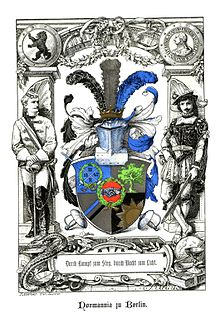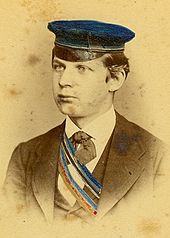Corps Normannia Berlin
| Basic data | ||||||
|---|---|---|---|---|---|---|
| founding | February 3, 1842 | |||||
| Colleges |
Humboldt University Berlin Charité University of the Arts Berlin Technical University Berlin Free University Berlin |
|||||
| SC | Berlin | |||||
| Association | Kösener SC Association | |||||
| Circle |
|
|||||
| Motto | Through battle to victory - through night to light! | |||||
| Colours |
|
|||||
| Fox colors |
|
|||||
| address | Klaus-Groth-Str. 4 14050 Berlin |
|||||
| website | https://www.corps-normannia.de/ | |||||
The Corps Normannia Berlin is a mandatory and colored student association at the colleges and universities of Berlin .
history
Normannia was founded on February 3, 1842 under the name Cerevesia or Weltkneipe . In February 1845 she declared herself to be the Normannia Landsmannschaft . In July 1855 a clear majority of the country team decided to continue as a corps in the future. This entered the Berliner SC and thus the KSCV. Some members of the former Landsmannschaft did not agree with this development, left the Corps and founded a new Landsmannschaft with the same name in the winter semester of 1855/56. This was apparently largely unknown to the student public. One saw a Landsmannschaft before and a Landsmannschaft after and therefore assumed, without knowing the background, that it was one and the same league from which the newly appeared corps had dropped out. At that time there was a procedure before the university court in which the inventory of the federal government was awarded to the corps as the rightful successor. The (new) country team had to change their circle by adding a slash and making it distinguishable from the one that was retained by the corps.
In misjudgment of the circumstances described, the country team was commonly referred to as Palaio-Normannia (= Old Normannia). Fierce rivalries between the two Givers resulted. Scale lengths between their relatives are said to have been the bloodiest in the SC. The Landsmannschaft Normannia, which remained next to the Corps, became the Berlin Burschenschaft Normannia in 1924 .
In 1925, Normannia was the presiding suburban corps in the KSCV and, with Conrad Stolte, provided the Kösener suburb spokesman. In the era of National Socialism , the Corps in 1935 brought into line and the camaraderie continued. In the post-war period , Normannia, like all other corps, remained banned by a resolution of the Allied Control Council . The Corps was reconstituted in Hamburg on October 23, 1950 , but returned to Berlin on March 31, 1953.
Corp houses
Behind the tenement house built in 1826 on Linienstraße , which was supplemented by a transverse building in 1857, Normannia built a corp house in 1909 in the second courtyard of the property by the architect Fedor Feit on behalf of Normannia AG as the client. The entire complex is now in the care of the historic monument .
As part of the 88th Foundation Festival, the Corps moved into the second corp house in Grunewald on June 27, 1930. It was built according to designs by Heinz Oppermann. The construct included the ground floor next to the reception and dining room utility rooms and the apartment of the Corp servant , upstairs in the Kneip hall with music gallery, a winter garden and the old boys' room, in the II. Floor CC-room, study the Chargierten, four active living spaces and the Paukboden . Two further lodging rooms were located in the attic.
Known members
In alphabetic order
- Helmut Allardt (1907–1987), ambassador
- Wilhelm Begemann (1843–1914), historian of Freemasonry
- Max Begemann (1877–1949), son of Wilhelm Begemann, singer
- Eckhart Dietrich (* 1937), presiding judge at the Supreme Court
- Heinrich Erythropel (1865–1940), Minister of State
- Hanns Heinz Ewers (1871–1943), writer
- Julius Falkenstein (1842–1917), doctor and traveler to Africa
- Fritz Feinhals (1869–1940), chamber singer
- Wilhelm Filehne (1844-1927), pharmacologist
- Rudolf Focke (1852–1918), librarian
- Herbert Gardemin (1904–1968), orthopedic surgeon
- Felix Genzmer (1878–1959), legal historian and Scandinavian
- Leopold Gerlach (1834–1917), educator and cultural scientist
- Anton Gründler (1829–1894), District Judge, Member of the Bundestag
- Max Hartmann (judge) (1841–1926), First President of the Düsseldorf Higher Regional Court
- Ernst Hein (1887–1950), German administrative lawyer and municipal civil servant
- Friedrich Hielscher (1902–1990), publicist
- Hugo Hoffmann (1838–1893), President of the Regional Court, Member of the Parliament
- Johannes Hoßfeld (1879–1946), founder of the customs border guard
- Jürgen Kanzow (1938–1997), pioneer of broadband communication
- Hermann Koechling (1867–1936), lawyer and notary, chairman of the Bochum civil society Harmonie
- Friedrich Krause (1856–1925), building officer
- Robert Krause (1831–1913), Landschaftssyndikus, MdHdA
- Lothar Kreuz (1888–1969), orthopedist, last rector of the Friedrich Wilhelms University in Berlin
- Michael Kühne (* 1949), metrologist
- Georg Lang von Langen (1868–1945), district director in Altkirch and Erstein, deputy chief magistrate in Sigmaringen, district administrator in Ziegenrück, chief administrator in Sulz, chief administrator and district administrator in Gaildorf
- Günther Lummert (1903–1968), lawyer
- Fritz Mussehl (1885–1965), State Secretary
- Ullrich Nauck (1852–1923), District Administrator of the Iserlohn district
- Werner Ranz (1893–1970), lawyer and notary, VAC chairman
- Karl-Ferdinand Reuss (1907–1973), lawyer
- Alfons Sack (1887–1944), lawyer
- Rudolph Schenck zu Schweinsberg (1855–1911), District Administrator of the Kirchhain District, Chamberlain, member of the Hessian Municipal Parliament
- Bernhard Schlegel (1913–1987), professor of internal medicine
- Heinrich Schoppen , († 1933), First Mayor of Gniezno, Lord Mayor of Łódź, Mayor of Marlow
- Jean Louis Sponsel (1858–1930), art historian
- Eberhardt Sturm (1889–1973), industrialist, roof tile manufacturer
- Ferdinand Trautmann (1833–1902), ENT doctor, medical officer, university professor at the Charité
- Louis Viereck (1851–1922), journalist and naturopath, MdR
- Hugo von Waldeyer-Hartz (1876–1942), naval writer
- Karl Hans Walther (1895–1965), General Physician of the Wehrmacht, Major General of the NVA
- Fritz Max Weiss (1877–1955), China expert, envoy
- Ernst von Werdeck (1849–1905), MdR
- Horst Wessel (1907–1930), SA storm leader
Holder of the Klinggräff Medal
The Klinggräff Medal of the Stifterverein Alter Corpsstudenten was awarded to:
- Arnold-Christoph Muhl (1989)
- Carl-Philipp Brenning (2010)
Relative Corps
Normannia Berlin is a member of the black circle of the Kösener Seniors Convent Association and maintains the following relationships with other corps:
- Friends
- Silesia
- Borussia Hall
- Suevia Munich
- Suevia Strasbourg
- Thuringia Leipzig
- Hansea Königsberg (extinguished)
- Alemannia Vienna to Linz
- Montania Leoben
- Vandalia Graz
- Gothia Innsbruck
- Saxonia Constance
- official conceptions
- Hassia-Giessen to Mainz
- Saxonia Hann. Münden (extinguished)
See also
Individual evidence
- ^ Ernst Hans Eberhard : Handbook of the student liaison system. Leipzig, 1924/25, p. 11.
- ^ Paul Goldschmidt: On the history of the Landsmannschaft Normannia in Berlin 1842-1902. Berlin, 1902.
- ^ Dietrich in: Materials on the history of the Corps Normannia Berlin (1992)
- ↑ Timeline
- ↑ Brief history of Normannia (fuchsenheft.de)
- ↑ 88th foundation festival and inauguration of the corp house of the Berlin Normans . In: Deutsche Corpszeitung 47 (1930/31), pp. 279–281.
literature
- Materials on the history of the Corps Normannia Berlin. Berlin 1992.
- Sven Waskönig: The everyday life of the Berlin fraternity students in the Third Reich using the example of the Kösener Corps at the Friedrich Wilhelms University. In: Christoph Jahr (Hrsg.): The Berlin University in the Nazi era. Vol. 1., Stuttgart 2005, pp. 159-178.







